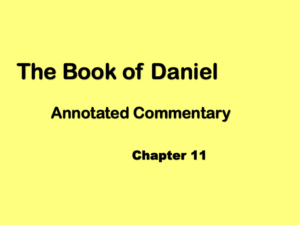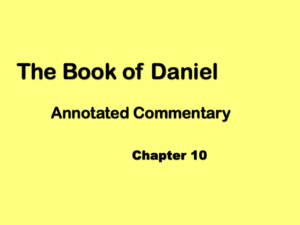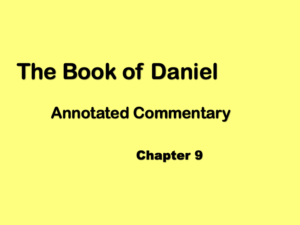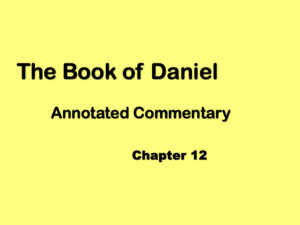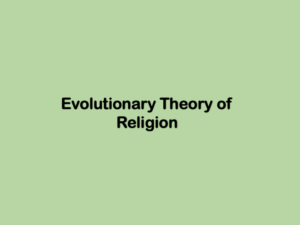Daniel 7: 1-6 The Four Beasts
In Chapter 7, Daniel returns to the topic of end times. This time, it is Daniel, and not Nebuchadnezzar, who has a vision. The topic is the same, future kingdoms of man, but now these future kingdoms are symbolized by violent beasts.
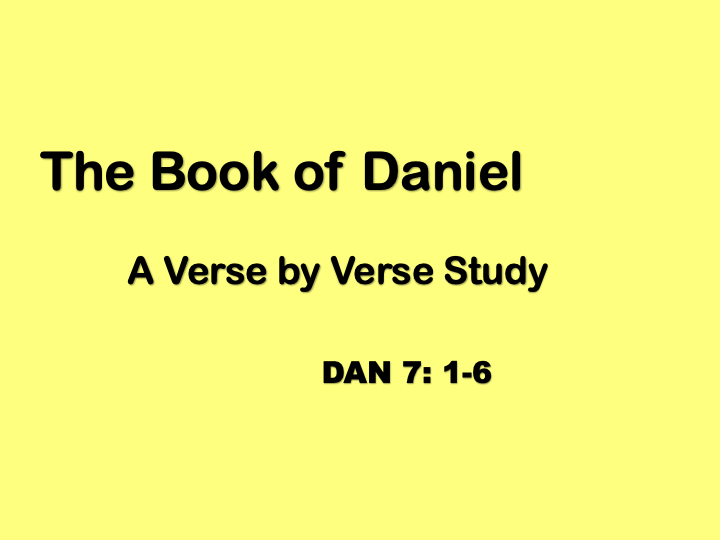
Daniel’s Vision
While chapters 1-6 follow a chronological order, this pattern is broken in chapter 7. Daniel returns to the first year of the rule of Belshazzar, which occurs chronologically between chapters 4 and 5. The topic of chapter 7 is the same of chapter 2, the future kingdoms of man, but now it is Daniel, and not Nebuchadnezzar, who has a vision, and now the kingdoms are represented as violent beasts, not as a statue of precious metal.
In the first year of Belshazzar king of Babylon Daniel had a dream and visions of his head on his bed. Then he wrote the dream and told the sum of the matters.
Daniel 7: 1
We know from historical records that Nabonidus became king in 556 BC. We also know from archeological finds that Belshazzar was the son of Nabonidus. In the Verse Account of Nabonidus, a clay tablet unearthed in Babylon in the last 1800s, we learn that Nabonidus left Babylon in the third year of his reign and made Belshazzar his regent.
… when the third year was about to begin – he [Nabonidus] entrusted the “Camp” to his oldest (son), the first born [Belshazzar], the troops everywhere in the country he ordered under his (command). He left (everything) go, entrusted the kingship to him and, himself, he started out for a long journey.
Verse Account of Nabonidus
This account places the first year of Belshazzar during the third year of Nabonidus, which gives us a date of 553 BC for the vision of chapter 7. For reference, the events of chapter 5 and the fall of Babylon occurred in 539 BC, fourteen years after Daniel’s vision.
Agents of Chaos
Daniel goes on to describe his vision. This will be the first of four visions given directly to Daniel.
Daniel spoke and said, “I saw in my vision by night, and behold, the four winds of the sky broke out on the great sea. Four great animals came up from the sea, diverse one from another.
Daniel 7: 1-3
The Aramaic word for wind here is ruhe, which is a cognate of the Hebrew word ruach. Ruach is translated as either wind, breath or spirit and is often associated with an act of God. For example, ruach is first used in Genesis 1.
In the beginning, God created the heavens and the earth. The earth was formless and empty. Darkness was on the surface of the deep and God’s Spirit (ruach) was hovering over the surfaces of the waters.
Genesis 1: 1-2
The “four winds of the sky” is also a reference for the entirety of earth and heaven, as in the North, East, South and West winds encompass all four directions, so therefore all of creation.
When used in the Bible, the “four winds” also usually precede some supernatural event, just as the ruach hovering over the surface of the waters preceded creation. The four winds precede the resurrection of the dry bones in Ezekiel 37 and accompany the exile of the Jews in Zechariah 2. Taken as a whole, these passages seem to equate an act of God with the wind (ruach) of the four winds.
In Daniel 2, the four winds act upon the great sea. Literally, this could be a reference to the Mediterranean Sea, as all of the subsequent kingdoms were located near the Mediterranean, but in the Bible, water, or the sea is often a metaphor for chaos. In Genesis, God brings the land out of the waters, bringing order out of chaos. This metaphor is repeated later in the Bible. The leviathan, a creature of chaos, lives in the sea, and a great creature of the sea swallows Jonah. In Revelation, the new earth will not have seas, a symbolic representation of the end of chaos (Revelation 21: 1).
In the early Bible, chaos is a natural force, the opposite of creation. But as the Bible progresses, agents of chaos emerge. These agents are more than the opposite of creation, they actively seek decreation. They oppose God, seeking death and destruction where God seeks life and creation. The ultimate agent of chaos, who evolves through the Old Testament before becoming fully realized in the New Testament, is Satan, the accuser.
The First Beast: Babylon
So God acts on the sea with the four winds, and creatures of chaos rise from the sea. This imagery suggests these creatures will oppose God’s way, seeking decreation and chaos.
“The first was like a lion, and had eagle’s wings. I watched until its wings were plucked, and it was lifted up from the earth, and made to stand on two feet as a man; and a man’s heart was given to it.
Daniel 7: 4
The majority of commentators agree that the lion is a reference to Nebuchadnezzar and the Neo-Babylonian Empire. The fact that its wings were plucked and it was made to stand on two feet is a reference to the events of Daniel chapter 4, when God humbled Nebuchadnezzar, who in turn came to proclaim his belief in the one true God. Nebuchadnezzar was transformed from an agent of chaos to an agent of God.
The Second Beast: The Medo-Persian Empire
The next creature continues to mirror the statue of chapter 2, with the Medo-Persian Empire following Nebuchadnezzar’s Neo-Babylonian Empire.
“Behold, there was another animal, a second, like a bear. It was raised up on one side, and three ribs were in its mouth between its teeth: and they said to it: ‘Arise! Devour much flesh!’
Daniel 7: 5
Again, most commentators agree this beast is Persia. It is Persia who conquered Babylon in 539 BC. Cyrus the Great was originally the king of Persia, a vassal king of the Medes, and perhaps a grandson of the Median king. After Cyrus defeated the Mede army in battle, he assumed the kingship of both the Medes and the Persians. The lop-sided appearance is said to reflect the uneven sharing of power, with Persia being the dominant partner. The command to “devour much flesh” may reflect the conquests of the Persian Empire and the three ribs are said to represent three early conquests: Lydia in 546 BC, Babylon in 539 BC and Egypt, under Cambyses, the son of Cyrus, in 525 BC.
The Third Beast: The Greek Kingdoms
After the bear, a third animal arises from the sea. This animal is “like a leopard.”
“After this I say, and behold, another, like a leopard, which had on its back four wings of a bird. The animal also had four heads; and dominion was given to it.
Daniel 7: 5-6
Again, Alexander the Great is historically known to have conquered the Persian Empire in 331 BC. In this vision, the leopard seems to correlate with the bronze of the statue, which correlates with the empire of Alexander the great. The four wings may represent the speed at which Alexander conquered the known world. The four heads may represent the four kings who eventually divided Alexander’s empire after his death. Interestingly, dominion, or the right to rule, was “given” to the leopard, and not taken, as we would expect from a conquering nation.
Hosea and the Three Beasts
The first three beasts of Daniel 7 mirror imagery used by an earlier prophet, Hosea. Hosea was a prophet of the northern kingdom of Israel and was active about a hundred and fifty years earlier than Daniel. In chapter 13, God warns the Israelites they have forgotten Him, so he will treat them as if her were a series of wild beasts: a lion, a bear and a leopard.
“Yet I am Yahweh your God from the land of Egypt;
And you shall acknowledge no god but me,
And beside me there is no savior.
I knew you in the wilderness,
In the lad of great drought.
According to their pleasure, so were they filled;’
They were filled, and their hear was exalted.
Therefore they have forgotten me.
Therefore I am like a lion to them.
Like a leopard, I will lurk by the path.
I will meet them like a bear that is bereaved of her cubs,
And will tear the covering of their heart.
There I will devour them like a lioness.
The wild animal will tear them.
You are destroyed, Israel, because you are against me,
Against your help.
Hosea 13: 4-9
Importantly from the warning of Hosea, it is God who will act like a lion, a leopard and a bear toward Israel. However, in Daniel, it is foreign nations who are portrayed as a lion, a leopard and a bear. A theme throughout Daniel is that it is God who decides who rules nations and who grants authority to rulers. While these rulers may be agents of chaos and their actions may yield death and destruction, it is ultimately God who allows their actions, ultimately to bring about His judgement.
Taken the imagery as a whole, the three kingdoms are agents of chaos, arising from the sea, but God will use them to punish the Israel and Judah. Other books in the Old Testament echo this idea. In Habakkuk, God tells His people that he will use the Babylonians to punish their sin. Isaiah, who lived several hundred years before the Medo-Persian Empire, calls Cyrus by name and proclaims the He will use Cyrus to “subdue the nations before him.” (Isaiah 45).
In the next post, we discuss the fourth and final kingdom, a kingdom that will “devour the whole earth.”
